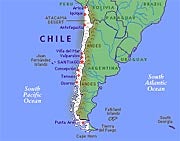The shutdown of Cerámicas Cordillera, a Chilean manufacturer of ceramic products owned by Belgian group Etex, has set off alarm bells throughout the country’s business sector. Cerámicas Cordillera has stood out on the local scene for 25 years because of its sizable profits.
Although Cordillera had a 43% share of the Chilean market for surfaces and coverings, it was unable to deal with the 600% increase in the price of natural gas, its principal input, over the past five years. The prices it paid were six times higher than the prices paid by its competitors in neighboring countries. That fact, combined with the decline of the dollar, made it impossible for Cordillera to compete against imports. As a result, 517 professional workers are now out on the street, and the company has $30 million of debt, which it has to address before declaring itself legally bankrupt.
Meanwhile, rumors circulate that several local companies could be going through a similar scenario. The CNC, Chile’s national chamber of commerce, along with national trade unions, have refused to identify those companies in order to avoid hindering any possible negotiations they are having with banks. Making that information public would generate even greater insecurity for labor.
“Rising energy prices and the low value of the dollar are hurting our exporters as well as those companies that supply the same domestic markets,” warns Alejandro Montecinos, professor at the business school of Adolfo Ibáñez University, “These two factors have combined to raise domestic production costs, and they mean companies earn less for what they produce. A range of imports now sells at prices that are more competitive than those supplied locally.”
Restrictions on Chilean imports of Argentine natural gas, and higher taxes on those shipments, have forced Chile’s energy producers to supply their network largely through diesel and liquid gas. The problem is that prices for those energy sources have risen by 150% since June 2006, which has had repercussions on the cost of electrical energy.
Christian A. Johnson, professor at the business school of the Adolfo Ibáñez University, notes that “the weakness in the U.S. economy and the decline in interest rates have had a global impact that has forced the rest of the world’s markets to flood themselves with low-cost dollars.” The dollar is barely worth about 450 Chilean pesos today, compared with 650 pesos two years ago.
The Impact on Competitiveness
According to Rodrigo Escobar, director of the graduate program in energy engineering at the Pontifical Catholic University of Chile, “This cocktail, consisting of higher energy prices and a falling dollar, is negatively affecting local companies.” Escobar notes that the price of energy today is so high that it outweighs any savings that a company could have made by achieving greater energy efficiencies. “As a result, the impact on production costs is just as important for those companies that have achieved a certain degree of energy efficiency.”
Germán Echecopar, professor at the business school of Adolfo Ibáñez University, discusses the impact of current conditions on export activity. “Lower prices, measured in Chilean currency, plus higher energy costs have combined to make margins evaporate. These conditions will continue for a while, which means that companies need to think about making drastic changes and looking long-term.”
According to Johnson, “The chief threat for exporters is the high competitiveness of products from other regions that have the capacity to make products at more competitive prices, whether it is because of the lower cost of labor [there] or because of tax subsidies.” Most local companies, he adds, have been left with no alternative but to pass on their higher costs to their final customers.
Echecopar says there is a danger that local companies are facing financial risks, whether or not those companies participate in international trade. “[Some] companies have already begun to take on debt denominated in Chilean pesos, and those that have higher levels of debt will have to face more onerous financial and operational costs concerning the price of their products.” That fact, he stresses, will lead to serious cash flow problems when those companies deal with their contractual obligations. They won’t be able to count on having enough revenues to pay their expenses. That, in turn, “could potentially lead them into bankruptcy.”
Escobar has a more pessimistic view. “If companies didn’t take measures before and their debts are [already] very high, they are trapped. They could assume even more debt or, perhaps, apply energy efficiency measures. But at these high levels, these are only going to be temporary measures.”
Impact on Small and Midsize Companies
Guillermo Paraje, a professor at the Adolfo Ibáñez University business school, believes that the market segment most affected by all this turmoil “are the small and midsize companies (SMEs) because of their lower capacity and scale of operations. Historically, they are more likely to go out of business in these kinds of conditions.”
According to Johnson, “Large companies can opt to cover themselves through foreign exchange hedging; that is, protect themselves in part against the ups and downs of the dollar. This is something that small and midsize companies cannot do; they must face the full impact of the volatility in the global currency [the U.S. dollar].” Johnson notes that small and midsize companies suffer the most because they have less financial backing “as well as less ‘collateral’ they can use to react to events that put their competitiveness to the test.”
Montecinos agrees that the drop in the dollar has less impact on major manufacturers, for whom it is easier to substitute capital for labor. “Meanwhile, small producers have fewer alternatives because of their limited cash flow. From this viewpoint, the intervention of the Central Bank [of Chile] in the price of the dollar is entirely justified.”
Recently, Chile’s monetary authority intervened in order to prevent the value of the peso from continuing to drop. The government of President Michelle Bachelet has also done its part, lowering taxes on fuel. Although these measures have been well received in the market, major local companies agree that they are insufficient.
Montecinos notes that the government could make it easier for disadvantaged sectors, such as SMEs, to get funding through loans that vary according to the companies’ levels of productivity. “The government must support the private sector in times of difficulty, and this is one of those times.”
Echecopar agrees with Montecinos, noting that “support from the government should also include soft, long-term loans to modernize the operations of the companies that are affected the most — in this case, SMEs.” On the other hand, although SMEs have fewer resources to deal with the transformations required by the global marketplace, “if they react quickly, they can find small niches in markets that are less affected by economic pressures, especially in the domestic [Chilean] market,” said Echecopar.
The Opportunities that Exist
Johnson sees some new opportunities, despite the adverse climate for local companies. He advises companies to consider taking advantage of the cheap dollar to buy new equipment and machinery; to replace antiquated infrastructure with advanced technology; and to take maximum advantage of what the financial system is offering in terms of low-interest loans.
In contrast, Echecopar notes, “The stability of the Chilean economy represents, in itself ,an opportunity to survive the crisis. We can count on having a more predictable base than other economies in the region, and our financial system is more developed.”
Nevertheless, for Montecinos, the main challenge facing exporters is how to innovate. Companies need to find niche products and add greater value to what they already produce. “Chile exports mostly commodities such as fruit, vegetables and other manufactured products. The exception to the rule is the salmon industry and the wine industry, which have innovated and incorporated the latest generation of technology into their processes.”
When it comes to research and innovation, there is little that companies can do all by themselves, notes Montecinos. However, he adds, “These conditions represent a great opportunity to establish collaborative networks and partnerships with the country’s universitie, via joint ventures.” Ties between the country’s business sector and its universities are practically non-existent, he points out. “These types of strategic alliances facilitate projects for undertaking innovations and making improvements in production processes, as well as in business management, administration and more technical areas such as technological infrastructure.”
Montecinos predicts that if these sorts of alliances materialize, the country will be in better shape to confront the ups and downs of the U.S. dollar and the rise in energy costs by providing higher value-added products at lower prices. “To achieve that, you have to take advantage of all the human capital available in Chile and set up these partnerships.”
Strategies for Alleviating the Crisis
The best strategy for exporters could be to negotiate in another currency, such as the euro, recommends Johnson. Exporters should also explore the possibility of protecting themselves by using forward foreign-exchange contracts and dollar options.
For his part, Paraje suggests “targeting new markets and avoiding too much concentration; avoid shipping just one kind of product, or shipping your products to just one destination. Clearly, this involves long-term strategy.”
As for the high price of energy, companies need to take a more complicated approach, explains Escobar. “The cost of energy is so complex, and many companies don’t take a strategic view of it. These companies just focus on their day-to-day operations. That is one of the reasons why most companies have not already carried out contingency plans for dealing with current conditions.”
Montecinos believes that Chile’s current energy infrastructure is helping to perpetuate the energy crisis. “We’ve committed ourselves to an energy plan that is bound to make energy more and more expensive. If the price of petroleum continues its upward trend, power plants that operate on a diesel base will find their costs going higher and higher,” he says. He also forecasts that current plans to construct electric power plants based on coal and liquid natural gas are insufficient to guarantee the supply Chile needs at competitive prices in 2012.
José Etcheverry, an energy researcher at the David Suzuki Foundation, a Canadian environmental organization that promotes sustainable development, suggests a long-term solution. “It makes sense for the country [Chile] to pay more attention to renewable energy sources and energy efficiency, which could become the foundation of a Chile that is more profitable and more advanced.”
Etcheverry recently participated in a conference called “Energy security and efficiency: A scientific contribution to the creation of public policy.” It was produced by the Pontifical Catholic University of Chile, and organized by Chile’s foreign ministry and Chiletodos, a non-profit group whose goal is to strengthen and promote the Chilean community overseas. Etcheverry stresses that the resource of photovoltaic solar energy is expected to continue growing in the future. Its use is already expanding within Canada.
“Actually, Canadian telecom systems already use a lot of photovoltaic systems because they are available at a low cost. This is an input that Chilean firms could consider in their business plans over the next five years,” says Etcheverry.
Carlos Monreal, a science researcher and consultant at Agriculture and Agri-Food Canada, a Canadian government agency, also participated in the energy summit. “Chile has tremendous potential in terms of its resources,” he states, “and it has a supply of biomass in its forests that can be heated on an industrial scale and used as alternative for generating thermal energy.”



